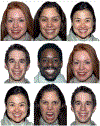Visual and behavioral responses to social and non-social threats: A multi-site replication
- PMID: 39549600
- PMCID: PMC11674623
- DOI: 10.1016/j.actpsy.2024.104612
Visual and behavioral responses to social and non-social threats: A multi-site replication
Abstract
Researchers have proposed that humans have evolved psychological mechanisms that facilitate the detection, rapid response, and subsequent avoidance of potential threats. However, some inconsistent results in the literature have called into question the robustness of these responses. Here, we sought to replicate previous findings on the rapid detection of both social (i.e., angry faces) and nonsocial (i.e., snakes) threats within a large and diverse sample of adults, and to examine the robustness of our effects across three data-collection sites using two response metrics-visual latency to detect threatening versus non-threatening stimuli and motor (i.e., button press) responses to indicate that threatening versus non-threatening targets had been detected. We found an advantage for both social (angry facial configurations) and non-social (snakes) threats across all three data collection sites, demonstrating that the phenomenon is both replicable and robust. Further, we found that the threat advantage was only significant for visual latency to first detect threatening stimuli and not for subsequent motor responses-the overall replication effect was driven by first fixations-suggesting that biases for threat might be perceptually based.
Keywords: Attention; Attentional bias; Rapid attention; Threat detection; Visual search.
Copyright © 2024 The Authors. Published by Elsevier B.V. All rights reserved.
Conflict of interest statement
Declaration of competing interest The authors of the current manuscript have no conflicts of interest to report.
Figures



References
-
- Bar-Haim Y, Lamy D, Pergamin L, Bakermans-Kranenburg MJ, & van IJzendoorn MH. (2007). Threat-related attentional bias in anxious and nonanxious individuals: A meta-analytic study. Psychological Bulletin, 133, 1–24. - PubMed
-
- Becker DV, & Rheem H (2020). Searching for a face in the crowd: Pitfalls and unexplored possibilities. Attention, Perception, & Psychophysics, 82(2), 626–636. - PubMed
-
- Blanchette I. (2006). Snakes, spiders, guns, and syringes: How specific are evolutionary constraints on the detection of threatening stimuli? Quarterly Journal of Experimental Psychology, 59(8), 1484–1504. - PubMed
-
- Burris JL, Buss KA, LoBue V, Pérez-Edgar K, & Field AP (2019). Biased attention to threat and anxiety: On taking a developmental approach. Journal of Experimental Psychopathology, 10(3), Article 2043808719860717.
MeSH terms
Grants and funding
LinkOut - more resources
Full Text Sources

